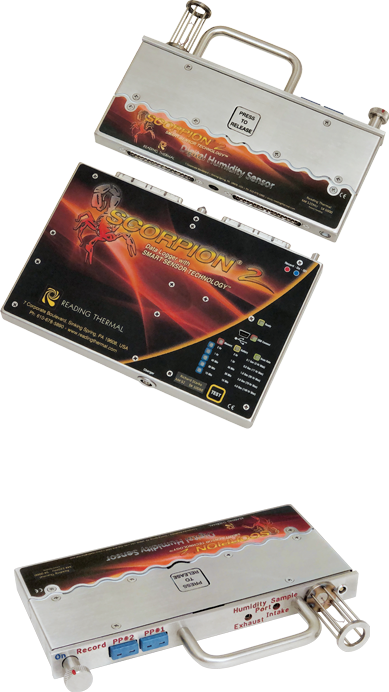Measuring humidity in your industrial bakery cooling tunnels and tunnel ovens with the new SCORPION® 2 Digital Humidity Sensor from Reading Thermal can help you measure and document both oven moisture and finished product moisture to achieve the best results.
Reading Thermal, a Reading Bakery Systems brand, has focused on studying the commercial baking process for more than 25 years. We manufacture and support the SCORPION® 2 Profiling System and Data Logger which measures and maps the key baking parameters of temperature, air velocity, heat flux and humidity.
The SCORPION® 2 enables you to monitor actual in-process conditions and get the critical information you need to correct problems and maintain optimum process control. This powerful diagnostic tool has become an industry standard for understanding and improving your proofing, baking, cooling and freezing processes.
Why is it Important to Measure Oven Humidity?
Products interact with the amount of moisture in the environment as they pass through the thermal process. This moisture often comes from the product itself and represents a delicate balance affecting finished product quality in many ways. For example:
- High oven humidity can increase the volume of your baked goods.
- High oven humidity can lighten the crust color of baked goods.
- Reducing evaporation can keep the surface of a cookie moist, allowing it to stretch and preventing cracks.
- Some products must maintain surface condensation to produce a concentrated sugar solution that gives the surface a glaze.
- The amount of moisture left in products after baking can impact their shelf life.
- The amount of moisture in a finished product can directly affect breakage during the packaging process.
The SCORPION® 2 Digital Humidity Sensor is designed to measure the moisture content of the thermal environment in both heating and cooling processes. It is applicable to proofers, tunnel ovens, dryers, and cooling tunnels.
Mechanically, the Digital Humidity Sensor is comprised of an Air Temperature sensor, two inputs for Product Core Temperature Measurement, and a proprietary humidity sampling system to measure Dew Point Temperature, Absolute Humidity and Relative Humidity.
The sampling system contains patent-pending Anti-Saturation Technology™ that allows measurements in high temperature and high dew processes seen in commercial biscuit & cracker and bread & bun ovens.
Analyzing the Results
In high temperature applications above 212°F (100°C), absolute humidity is displayed. The user can choose between % Moisture by Volume or Humidity Mass Ratio (lb water/lb dry air or kg water/kg dry air).
In low temperature applications below 212°F (100°C), % Relative Humidity is displayed.
In both high and low temperature applications, the dew point temperature and dry bulb air temperature is displayed.
Humidity in ovens is generally controlled by extraction fans and dampers. In proofers, the Digital Humidity Sensor is used to document the temperature and relative humidity of the proof cycle. In cooling tunnels, it is used to monitor dew point temperature to prevent condensation on the product surface which causes blooming.
Measuring the humidity in your industrial bakery tunnel ovens and cooling tunnels can take your baking to a whole new level. The SCORPION® 2 Profiling System and Digital Humidity Sensor from Reading Thermal can help you achieve excellent results. With the right amount of humidity, your products will bake efficiently.

